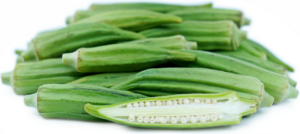OKRA may not be as famous as any other usual ingredient in a salad mix but amongst Filipinos, there’s something about it that leads one to home. And while I have a definite love for it to research and find out it was not a vegetable all this time, here’s what else I found out.
1. The term “okra” commonly refers to a long, green, slightly fuzzy, edible seedpod.
While many include and prepare it as a food, you might be interested to know that it is a fruit of a blossoming plant of the Mallow family. If you are fond of wearing cotton shirts and taking your picture with hibiscus worn on your ear, they belong amongst the Mallows too.

2. This okra plant loves the sun and grows best in warm, tropical and subtropical regions.
Here are some of the claims made based on this very nature of the fruit.
The Abyssinia region of Africa, which we now call Ethiopia propagated it mostly. Okra’s cultivation went stale and became isolated over the centuries because of its harsh topography. But as soon as it found its way to North Africa, South Asia, and East Mediterranean, it did not take long for it to grace the world with its popularity. The United States called it the Gumbo, in India – the Bhindi, and of all, England gave it quite a special label as Lady’s Fingers, referring to its shape.

3. Okra is a whole pack of nutrients.
It is rich indeed in Vitamin C and K with boasts of Thiamine, Folate and Magnesium.
Potent – C
Okra is full of ascorbate, ascorbic acid, or most commonly known as Vitamin C. It owes its antioxidant properties to which as it helps the skin looking young and vibrant. It can help boost the immune system, protecting one’s body from harmful viruses and bacteria. Moreover, vitamin C aids in the growth and repair of bodily tissues, allowing the skin to rejuvenate as it facilitates collagen formation and skin pigmentation. Okra pods are a good source for it to help out in meeting the recommended daily allowance (RDA) per 100 grams which is 36%. As our body is not able to store Vitamin C, daily consumption is highly adised. (Vitamin C RDA for adults – 65 to 90 mg/day with an upper limit of 2000 mg/day).
Blood and Bone Buddy
Vitamin K has a key role in blood coagulation and bone development necessary to prevent fractures and fortify bones. According to the U.S. Food and Drug Administration (FDA), okra contains sufficient vitamin K to be recognized as an excellent source of the said vitamin. Lack of this vitamin increases the risk of osteoporosis, bone fractures and excessive bleeding if injured. So, do include okra in your diet for a preventive benefit.

Stress Shield
Our bodies use Thiamine, also known as vitamin B1 to utilize carbohydrates and control electrolyte flow between nerves and muscle cells of limbs. Supported by research, Vitamin B1 is known as the “anti-stress” vitamin as it improves the body’s capacity to control mood. Moreover, okra seed extracts contain polyphenols and flavonoids, on top of the antioxidants that hold it all together, are all beneficial to the body. Lastly, this combination helps in reducing stress and decreasing fatigue.
No Pressure
Magnesium regulates blood pressure, supports the immune system and aids with nerve and muscle function. These activities account for the adult human body to at least have an intake of 100mg/day of Magnesium, as recommended to be done daily. 70 milligrams per cup of okra can serve as a good source as deficiency may lead to an array of health problems, including but not limited to:
-
-
- migraine
- type 2 diabetes
- Alzheimer’s disease
-
Babies, Breastfeeding and B9
The 2015-2020 Dietary Guidelines for Americans recommends that at least 400 micrograms of Folate (also known as folic acid and Vitamin B9) should be consumed by adults, especially all women of childbearing age. As an essential nutrient that aids the brain development of a fetus during pregnancy, and after, while breastfeeding, it helps decrease the risk of neural tube defects. Okra, being a great source of folate, can provide 15% of one’s RDA for folate.
4. Okra seeds are necessary for planting and growing, but did you know that it once became a substitute for a coffee bean?
In 1861, during the American Civil War, importation of coffee got disrupted which led to okra seeds becoming a substitute. Until now, okra seeds get roasted and ground as a caffeine-free alternative. Okra coffee alleviates people suffering from heart diseases. Extract bright, good-smelling and good-tasting yellow oil with a greenish tint by pressing the seeds. It is also a very good source of linoleic acid, (a polyunsaturated fatty acid) and omega-6. They are both vital for boosting brain health. It reduces the risk of heart disease and improving the reproductive system function. But since it contains such fatty acid, moderation is still key.
5. Brew the okra leaves into a helpful concoction.
The okra leaves are often used as a poultice – a soft, heated and medicated mass, applied externally and held in place with a cloth to manage inflammation. When brewed into tea, the combined okra leaves and flowers may treat bronchitis and pneumonia. Okra leaves can be eaten raw, as in salads. They can be cooked and used in soups and stews. Should you wish to reduce its spiny texture, use heat by sautéé or stir-fry.
6. Something to Stem From

Steaming the okra stems allows one to obtain fibres that are about 2.4 mm long which may be utilised in many ways. There is one that is an alternative for jute, a bast fibre that can be made into rough, strong threads. Weaving sacks or mats benefit from the production of rope and twine out of Jutes. As for its industrial functions, fortified polymer composites, both natural and synthetic, may be produced. Moreover, several qualities of the mucilage from the okra stem get explored on how it can aid in recycling. In the same line, it helps in treating water by removing haziness or cloudiness through its flocculent property making it reusable. Okra mucilage’s vast potential extends to getting developed as a biodegradable polymer that may be used for food packaging due to its similarity with polysaccharide film in composition.
7. The awesome okra leaves nothing behind that even its roots can be used as medicine.
Just as it is very rich in mucilage, okra’s roots are exceptional for its medicinal uses. Namely, plasma replacement and syphilis treatment are popular ones. Nepal, Turkey and China use the root in treating abrasions and boils externally. Additionally, the root when used for decoction relieves urethral and vaginal inflammation along with other genital conditions.
For a long time, the humble AWE-kra has stayed discreet.
It’s time to recognize it not only for its benefits for the body but also its industrial capacity. In a nutshell (or in this case, a seedpod), okra is one of those polarizing food due to its texture. Its sliminess often overshadows its clean and pleasing flavour. But don’t discredit the awesome okra just because of its texture, for this dynamite is an explosion of nutrients. The benefits of eating okra totally outweigh its not so desirable qualities. Furthermore, there is more to okra than meets the eye. Every part of this awesome plant is utilisable. It is time to give the humble okra the recognition it deserves.

